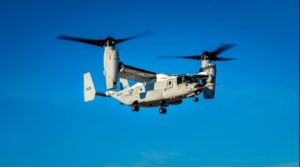The Defense Department approved all variants of the V-22 Ospreys for flight clearance following a months-long review into the cause of a deadly Air Force crash in November.
Naval Air Systems Command (NAVAIR) said it worked with the Air Force-led crash investigation to identify the specific materiel failure that caused the mishap.

The November 2023 crash off the coast of Japan that killed eight airmen is still under investigation, but the services said they feel they are prepared to avoid further crashes and can return the Ospreys safely to flight operations via their individual processes.
The Defense Department did not disclose what specific component failed and led to the crash.
“Close coordination among key senior leaders across the U.S. Navy, U.S. Marine Corps, and U.S. Air Force has been paramount in formulating the comprehensive review and return to flight plan, and this collaboration will continue,” NAVAIR said in a statement.
NAVAIR also said the return to flight decision “follows a meticulous and data-driven approach prioritizing the safety of our aircrew.”
The Pentagon grounded V-22s starting Dec. 6 after the preliminary investigation indicated a materiel failure of a component caused the crash off the coast of Japan (Defense Daily, Dec. 8, 2023).
DoDs uses three Osprey variants: the Navy’ CMV-22B, Marine Corps’ MV-22 and the Air Force’s CV-22.
The Navy said it implemented maintenance and procedural changes to address the materiel failure, with each service executing their own independent return to fight plans.
The service also said it is specifically “implementing a deliberate, multi-phased, conditions-based approach that will prioritize safety during the CMV-22 return to flight.”
Fleet Logistics Multi-Mission (VRM) Wing will now oversee a “comprehensive plan that includes enhanced maintenance checks and tailored training to renew aircrew currency and unit readiness,” commander of Naval Air Forces said in a statement,
The Marine Corps’ approach has three phases focused on regaining flight currency and proficiency for pilots and aircrews, squadron-level training to be able to conduct core missions, and pre-deployment training for a unit’s next mission.
The service also said that despite the general V-22 grounding Marines in Africa were cleared to fly their MV-22s “under a very specific operationally necessary banner” for U.S. Africa Command.